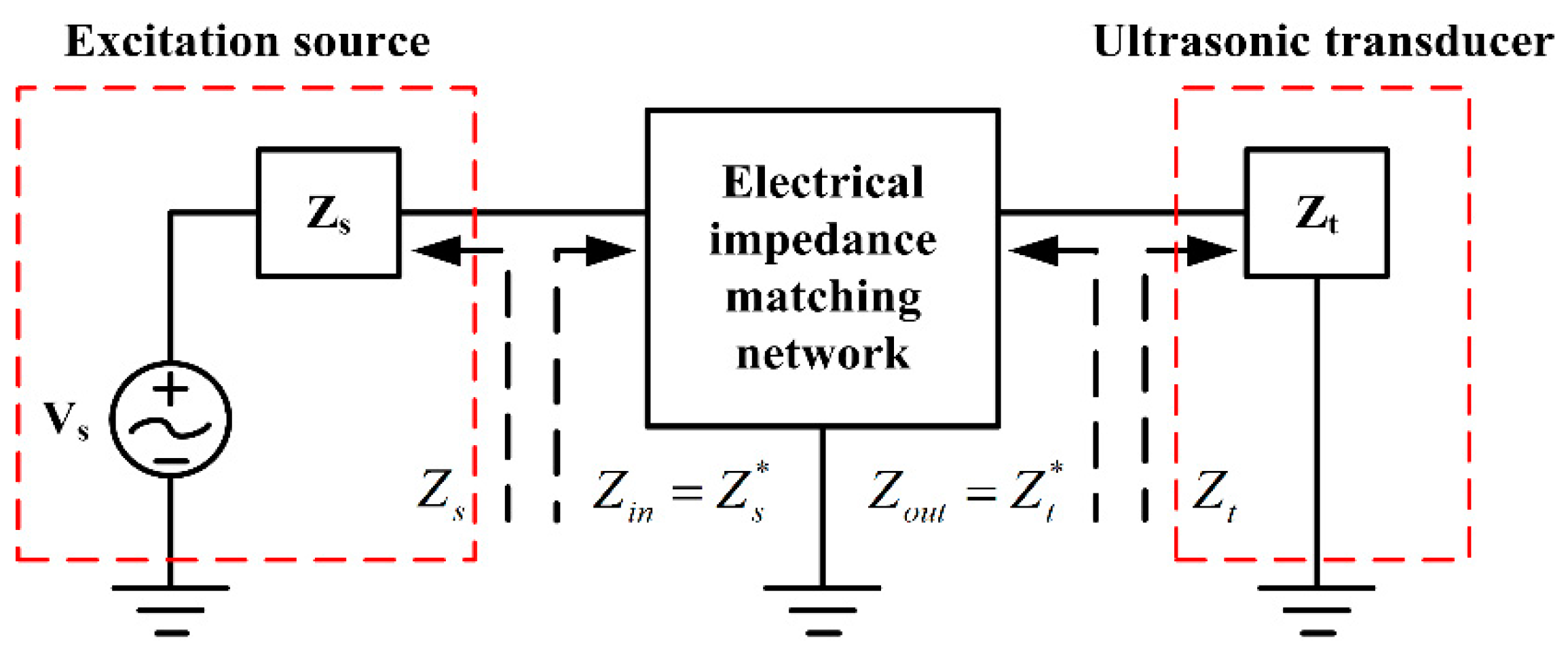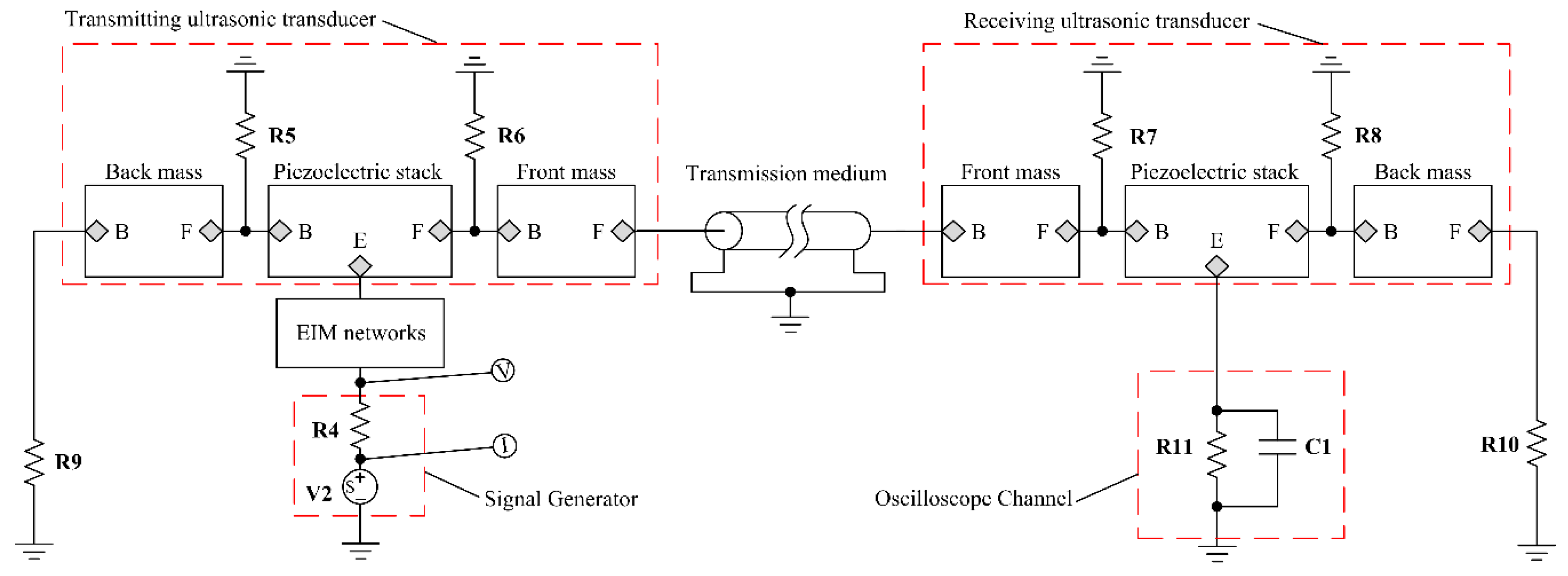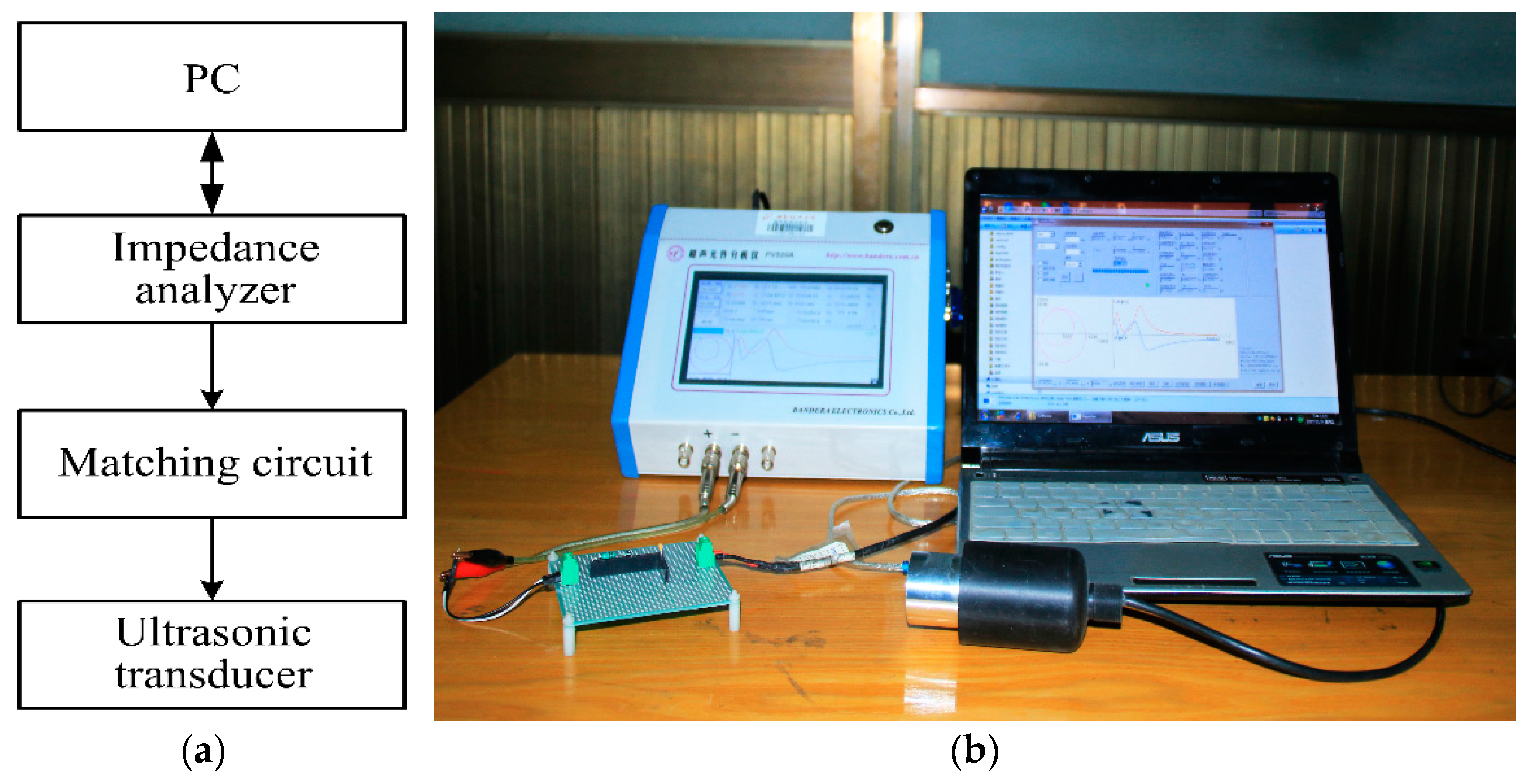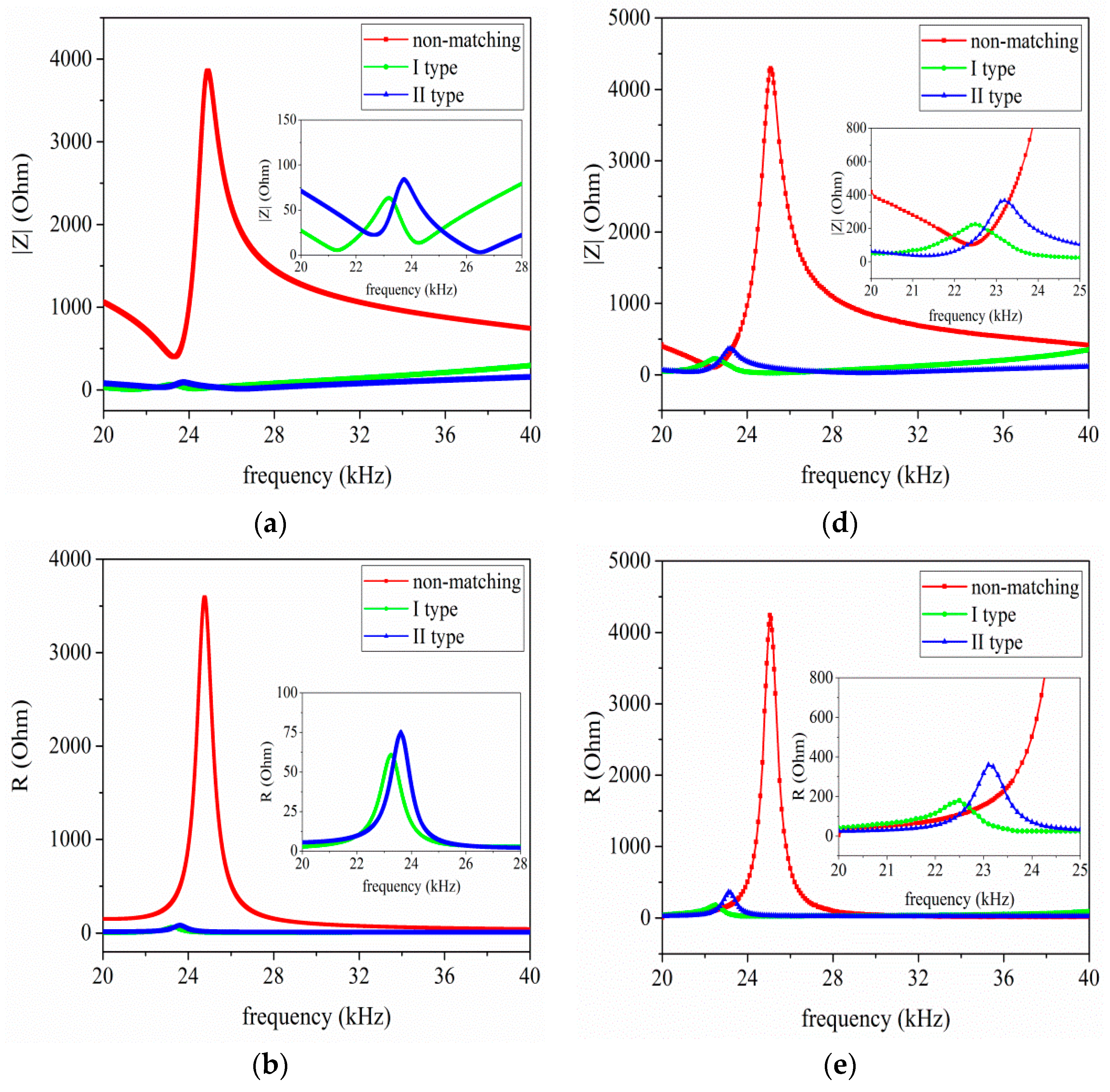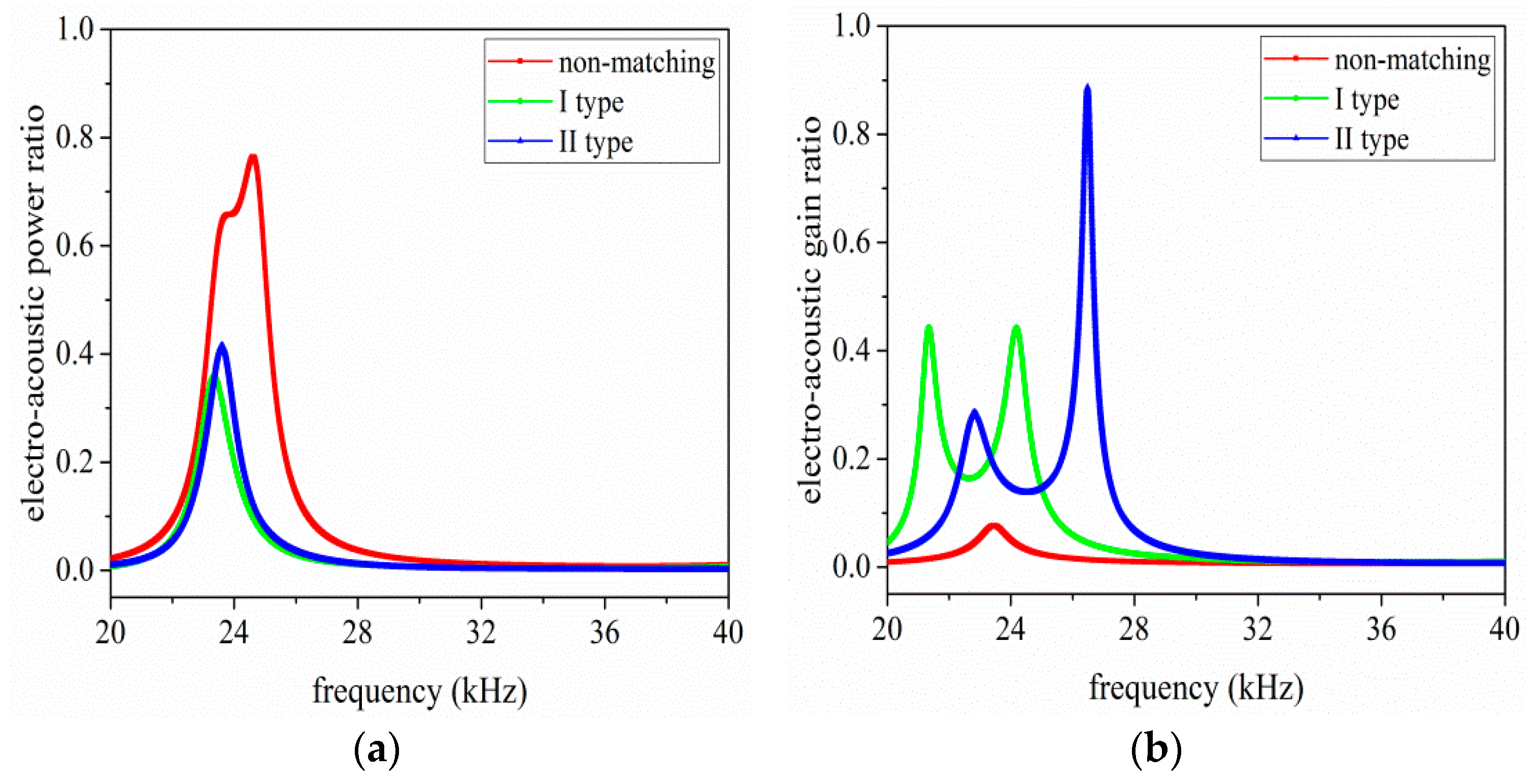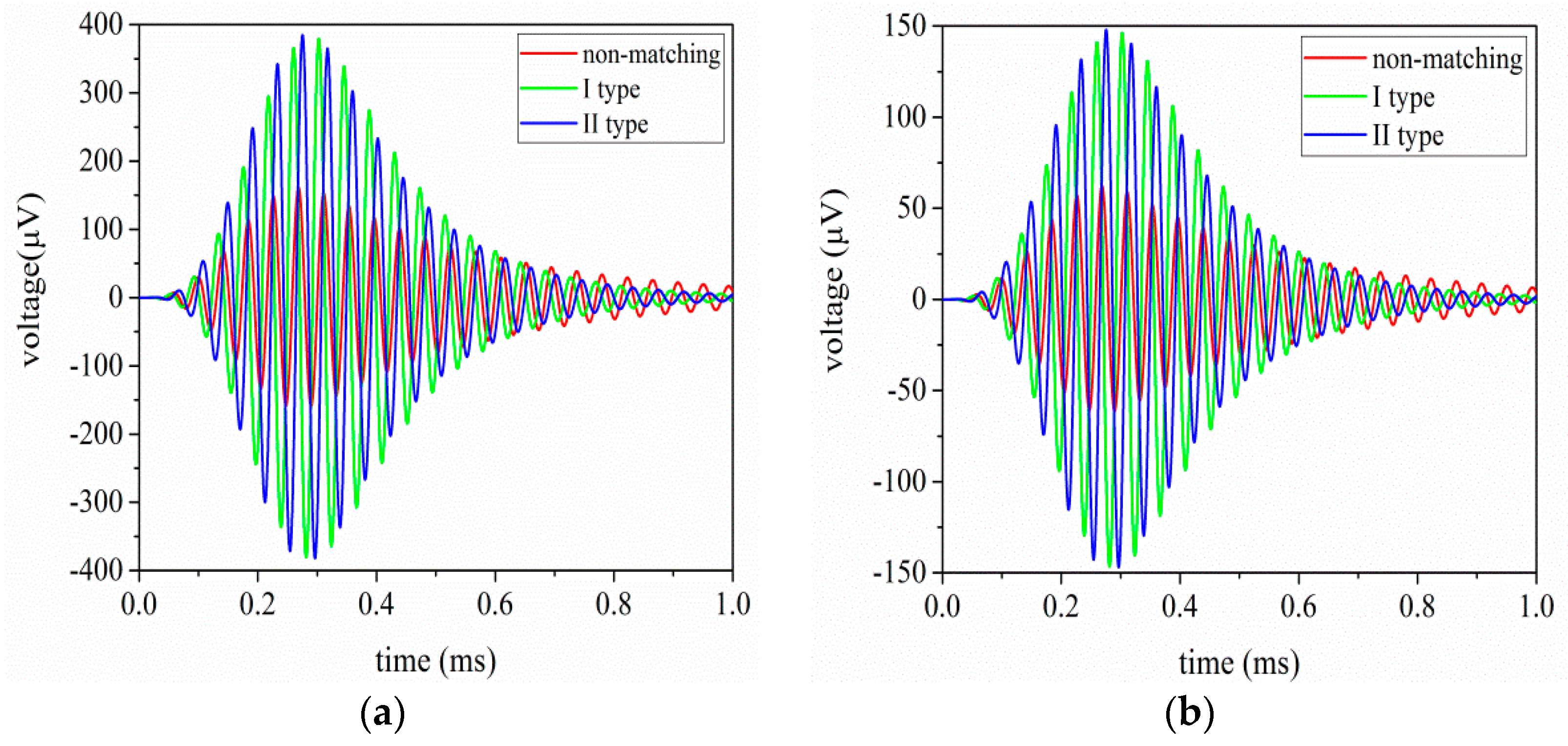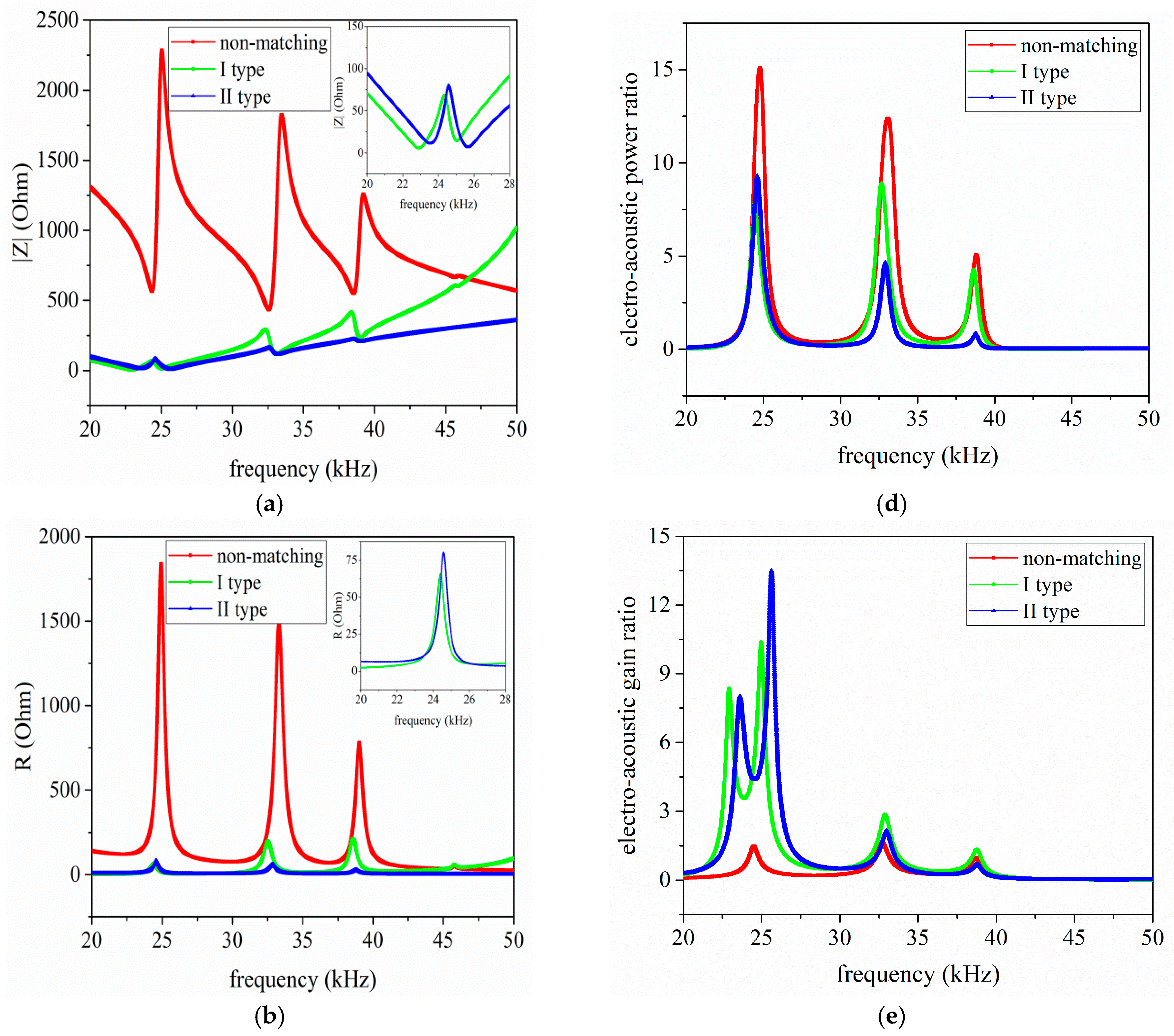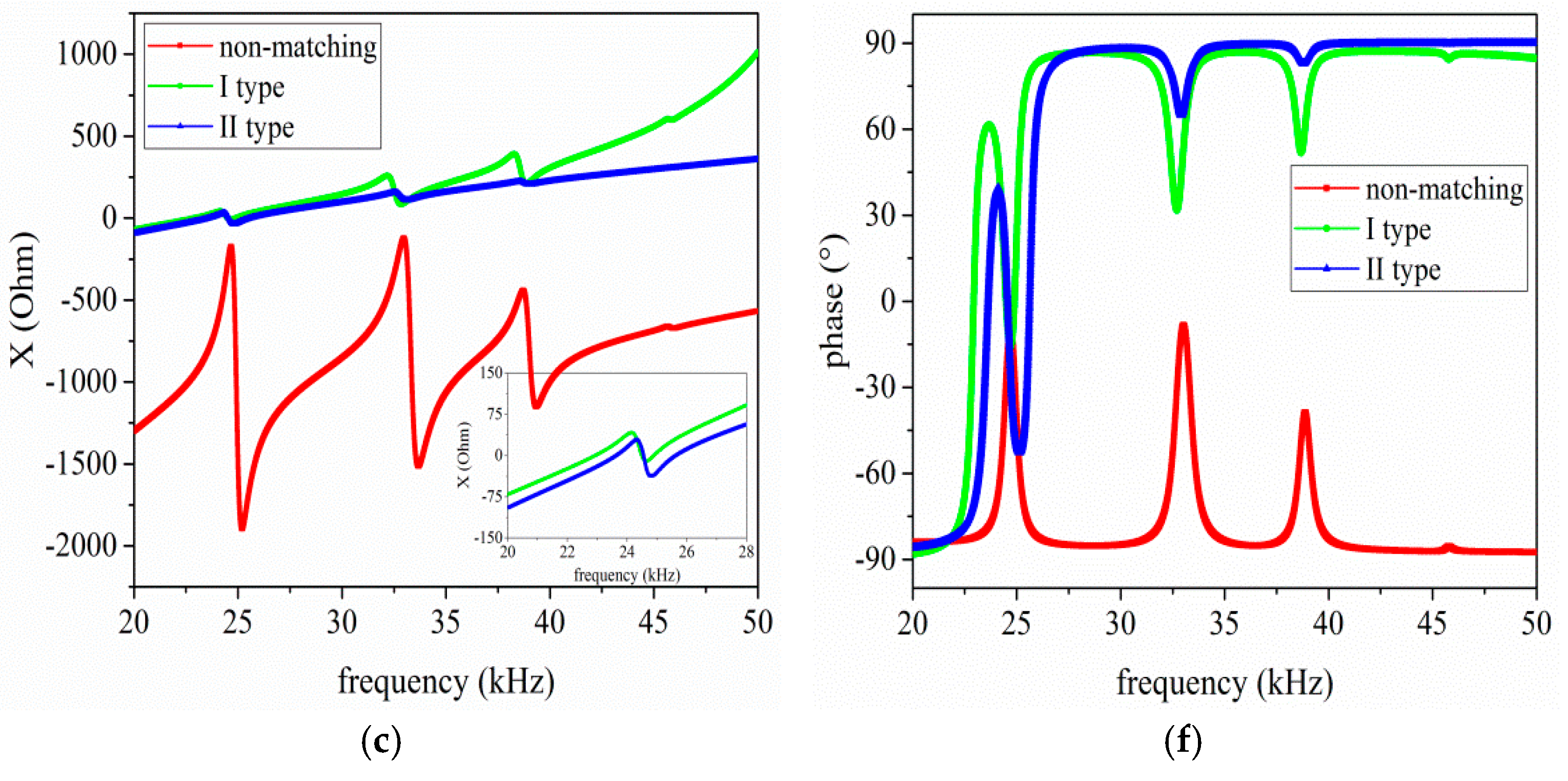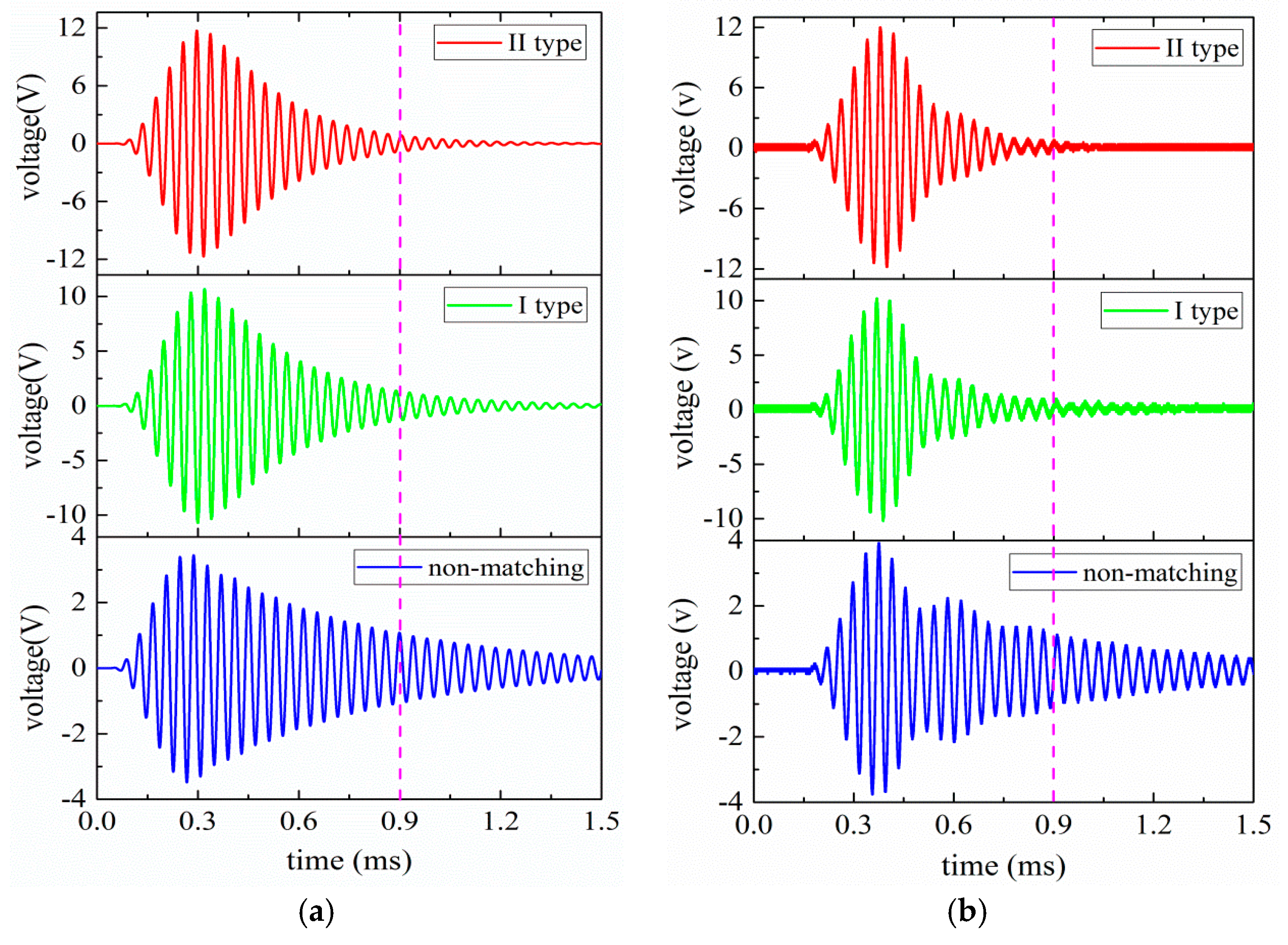In this section, the EIM theory for piezoelectric ultrasonic transducers, the used model of single sandwiched piezoelectric ultrasonic transducer, and the parameters calculation of EIM networks, the definition of performance parameters for the single sandwiched piezoelectric ultrasonic transducer, and the pitch-catch setup are illustrated in detail as follows.
2.1. The EIM Theory of Piezoelectric Ultrasonic Transducers
An ultrasonic wave transmitter usually can be simplified, as shown in
Figure 1. The EIM network lies in between an excitation source and a piezoelectric ultrasonic transducer. According to the impedance matching theory, the maximum power transmission of ultrasonic transducers can be obtained, when the input and output impedances of an EIM network (
and
) are just equal to the complex conjugates of the electrical impedance of an excitation source (
) and of a piezoelectric ultrasonic transducer (
) at resonance frequency, respectively. It is known that the electrical impedance is composed of resistive and reactive components. They can be expressed as
Here, represents the imaginary unit and is operating angular frequency.
However, as for an optimal electrical impedance matching network, the input and output electrical impedance of the EIM network can be indicated as
Here, and are the complex conjugates of and , respectively.
2.2. The PSpice Model of Single Sandwiched Piezoelectric Ultrasonic Transducer
The sandwiched piezoelectric ultrasonic transducer with EIM networks is shown in
Figure 2. It consists of the thickness polarized piezoelectric ceramic stack, the front and back metal masses, which are clamped together by means of a central prestressed bolt.
The EIM networks can effectively implement the compensation of the reactance and the tuning of the resistance for single sandwiched piezoelectric ultrasonic transducer. The piezoelectric ceramic stack is composed of four identical piezoelectric rings, which are thickness polarized in opposite directions. The arrow represents the polarized direction of piezoelectric ceramic rings as shown in
Figure 2. It should be noted that the piezoelectric ceramic rings located in the piezoelectric ceramic stack are connected together mechanically in series, however they pertain to the parallel relationship in electrical terminals [
24]. Specially, to simplify the analysis about the vibration state of the sandwiched piezoelectric ultrasonic transducers from
Figure 2, some assumptions must be made as follows: (1) the diameter of the sandwiched piezoelectric ultrasonic transducer must be much less than its longitudinal length; (2) according to the network cascade theory, the piezoelectric ceramic stack can be regarded as a piezoelectric ceramic round stick poled along the axial direction when the thickness of the single piezoelectric ceramic ring is much less than its diameter; and, (3) the displacement and force are continuous on both sides of the connection surface for each component in sandwiched piezoelectric ultrasonic transducers. It should be pointed out that the mechanical boundary conditions of the sandwiched piezoelectric ultrasonic transducers are axially free and radially fixed. But, the radial boundary condition is not fixed in practical application. Then, the PSpice model of single sandwiched piezoelectric ultrasonic transducer with EIM networks based Leach’s equivalent circuit model and transmission line [
20] is built, as shown in
Figure 3. The resistances
and
are the air load and have the value
[
25]. Also, the resistances
and
are used to model the bonded layer and have the value
. Then, the resistance
is the internal resistance of excitation source
.
On the basis of the PSpice model as shown in
Figure 3, the PSpice model of the pitch-catch setup with EIM networks is established as shown in
Figure 4. From
Figure 4, the pitch-catch setup is composed of excitation source, two sandwiched piezoelectric ultrasonic transducers, and the transmission medium, oscilloscope channel, EIM networks. Besides, it should be pointed that the transmission medium is modeled by the lossless transmission line.
The resistance
and the capacitance
are used to represent the oscilloscope channel. Similarly, the resistance
is the internal resistance of excitation source
. Then, the resistances
and
indicate the air load and have the value
. It should be noted that the materials of the front and back metal masses, the piezoelectric ceramic stack are hard aluminum, steel, and PZT-4, respectively. They are illustrated in detail [
20]. Then, the simulated electrical impedance at resonance frequency and the anti-resonance frequency of the piezoelectric ultrasonic transducer and the pitch-catch setup are listed in
Table 1.
Here,
,
are resonance and anti-resonance frequencies,
is input electrical impedance at resonance frequency. Specially, the simulated electrical impedance at resonance frequency from
Table 1 will be used for the parameters calculating of EIM networks in
Section 2.4.
2.3. The Parameters Definition for the Single Sandwiched Piezoelectric Ultrasonic Transducer and the Pitch-Catch Setup
In this section, the parameters, such as input electrical impedance, reactance and resistance, electro-acoustic power and gain ratio, and vibration velocity ratio, effective electromechanical coupling coefficient are defined.
The input electrical impedance can be expressed as
Here, and represent the input electrical impedance of the single sandwiched piezoelectric ultrasonic transducer and the input electrical impedance of the pitch-catch setup, respectively. Then, and indicate the voltage across resistances and , respectively. In addition, and are the current of through resistances and .
From Equation (3), the reactance and resistance can be obtained as
Here, and are the resistance and reactance of single sandwiched piezoelectric ultrasonic transducer, respectively. Then, and are the resistance and reactance for the pitch-catch setup, respectively.
From
Figure 3, the electro-acoustic power and gain ratio for single sandwiched piezoelectric ultrasonic transducer can be derived as
where
,
are the electro-acoustic power and gain ratio, respectively. Then,
,
represent the consumed powers of resistances
and
separately while
is the input electrical power.
,
are the excitation voltage and the radiated acoustical pressure from the front metal mass, respectively.
Then, the vibration velocity ratio between the front mass and the back mass is expressed as
Here, , represent the vibration velocities of the front mass and the back mass, respectively.
Similarly, from
Figure 4, the electro-acoustic power and gain ratio for the pitch-catch setup can be obtained as
Here,, are the electro-acoustic power and gain ratio, respectively. Then, , indicate the radiated powers from the front and back metal masses, respectively. is the received power, while is the input electrical power. In addition, and are the excitation voltage and the received voltage.
In addition, the effective electromechanical coupling coefficient
can be indicated as [
19]:
Here, , are resonance and anti-resonance frequencies, respectively. It should be noted that the effective electromechanical coupling coefficient depends on many factors, such as the materials, dimensions and structures, the electrical and mechanical loads.
2.4. The Parameters Calculation of EIM Networks
In this section, the parameters calculation of EIM networks for the single sandwiched piezoelectric ultrasonic transducer is illustrated. The specific calculation process mainly has two steps: (1) By using impedance analyzer (PV520A, BEIJING BAND ERA Co., LTD., Beijing, China), the input electrical impedance at resonance frequency is derived; (2) The parameters of EIM networks are conveniently obtained using the Smith chart tool (Smith V3.10 is designed by Prof. Fritz Dellsperger and Michel Band, Bern University of Applied Sciences, Bern, Switzerland.). The EIM networks that are used in this paper, which mainly include I type (series capacitance and parallel inductance) and II type (series inductance and parallel capacitance), as shown in
Figure 5.
In the case of matching single sandwiched piezoelectric ultrasonic transducer, the load impedance is the input electrical impedance, which is likely to be seen at the far right end of the Smith chart as shown in
Figure 6. In general, the source impedance is usually
, which is located at the center of the Smith chart. The EIM matching network is used, therefore, to move the load impedance to the
impedance point by means of adding capacitances or inductances in series or in parallel. An inductance in parallel moves the impedance point along the constant conductance curves, while a capacitance in series moves the impedance point along the constant resistance curves. Similarly, a capacitance in parallel moves the impedance point along the constant conductance curves, however, an inductance in series moves the impedance point along the constant resistance curves.
